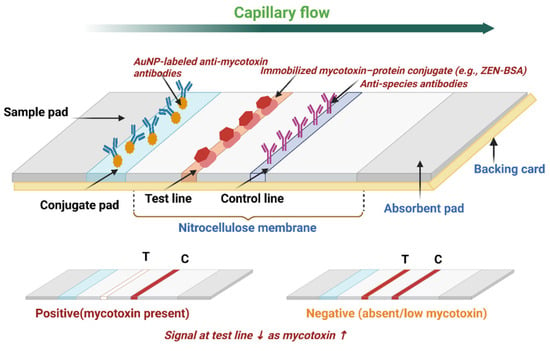Figure/Legend
In the original publication [], there was a mistake in the figure and legend of “Figure 1. Schematic of a competitive lateral flow assay (LFA) for mycotoxin detection”. “A sandwich immunoassay design was included for the schematic of a LFA”. The correct figure and legend appear below. The authors state that the scientific conclusions are unaffected. This correction was approved by the Academic Editor. The original publication has also been updated.

Figure 1.
Schematic of a competitive lateral flow assay (LFA) for mycotoxin detection. The assay consists of a sample pad, conjugate pad, nitrocellulose membrane with test (T) and control lines (C), absorbent pad, and backing card. AuNP-labeled anti-mycotoxin antibodies migrate with the sample by capillary flow and interact either with free mycotoxin analytes (hapten) in a solution or with the immobilized mycotoxin–protein conjugate (e.g., ZEN–BSA) at the test line. In the presence of mycotoxin, free analytes compete for antibody binding, resulting in a reduced or absent signal at the test line, while the control line remains visible, confirming assay validity and a positive result. The signal intensity at the test line is inversely proportional to the mycotoxin concentration in the sample (bottom left). In contrast, when the mycotoxin is absent, antibody–nanoparticle conjugates bind to the immobilized conjugate, generating a visible signal at the test line alongside the control line, indicating a negative result (bottom right). Red arrows indicate that signal intensity at the test line decreases as mycotoxin concentration increases (created with Biorender).
In the original publication, there was a mistake in the figure and legend of “Figure 2: Schematic representation of label designs”. “A sandwich format was included for the signal amplification of LFA”. The correct figure and legend appear below.

Figure 2.
Schematic representation of label designs (A) and detection readers (B) used for signal amplification in lateral flow assays for mycotoxin detection. Labeling strategies include nanoparticles, enzymes, surface-enhanced Raman spectroscopy (SERS), and fluorescent labels. Reader technologies range from visual inspection to portable optical, and Raman devices, with smartphone-based digital readers offering field-deployable quantification (created with Biorender).
Reference
- Thenuwara, G.; Akhtar, P.; Javed, B.; Singh, B.; Byrne, H.J.; Tian, F. Recent Advancements in Lateral Flow Assays for Food Mycotoxin Detection: A Review of Nanoparticle-Based Methods and Innovations. Toxins 2025, 17, 348. [Google Scholar] [CrossRef]
Disclaimer/Publisher’s Note: The statements, opinions and data contained in all publications are solely those of the individual author(s) and contributor(s) and not of MDPI and/or the editor(s). MDPI and/or the editor(s) disclaim responsibility for any injury to people or property resulting from any ideas, methods, instructions or products referred to in the content. |
© 2025 by the authors. Licensee MDPI, Basel, Switzerland. This article is an open access article distributed under the terms and conditions of the Creative Commons Attribution (CC BY) license (https://creativecommons.org/licenses/by/4.0/).